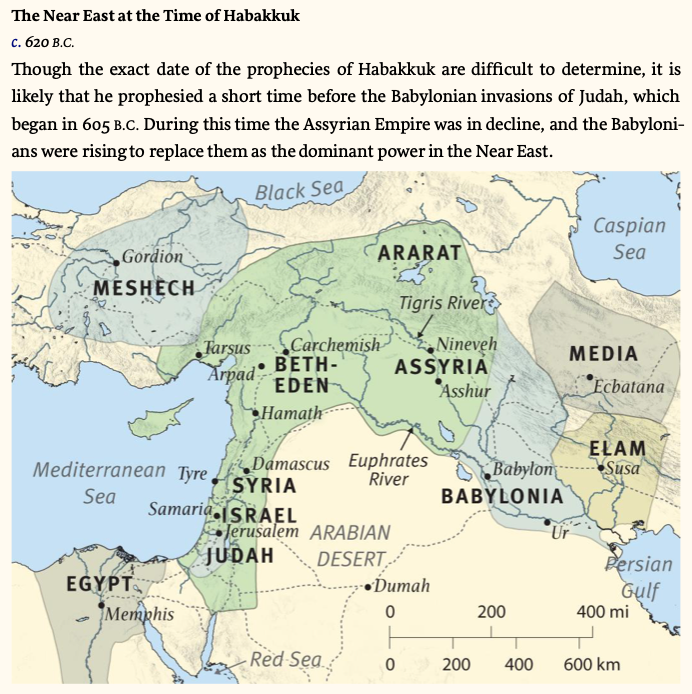당시 근동의 정세는 앗수르(앗시리아)에서 바벨론(갈대아), 페르시아로 이어진다. 하나님께서는 북이스라엘의 심판을 위해서 앗수르를 사용하셨다.(B.C. 722) 이제 앗수르와 남유다를 심판하시는데에 바벨론을 사용하실 것이다. 이는 결국 B.C. 586년에 성취된다.
이처럼 하박국은 유다에서 활동을 했는데 국제 정세의 변화속에서 하나님께서 이들을 어떻게 사용하셨는지를 바라보았다.
하박국의 중심 주제는 어떻게 하나님께서 바벨론과 같은 악한 나라를 당신의 신적인 목적을 위해서 사용하실 수 있는가이다. 이 책은 여러가지의 주제를 다루는데 욥기와 비슷하다. 욥기가 개인적인 스케일이라면 하박국은 국가적인 스케일에서의 신정론의 주제를 다룬다. ‘의인은 그의 믿음으로 살리라”라는 표현은 신약에서 세번이나 인용되었다.
The “theme question” of Habakkuk is, how can God use a wicked nation such as Babylon for his divine purpose? God judges all nations, said Habakkuk, and even Babylon would eventually be judged (Babylon fell to Persia in 539). Though God’s ways are sometimes mysterious, “the righteous shall live by his faith” (2:4) while awaiting salvation. These words are quoted three times in the New Testament (Rom. 1:17; Gal. 3:11; Heb. 10:38).
The Holy Bible: English Standard Version (Wheaton, IL: Crossway Bibles, 2016), 합.
저작 시기
The only hint of a date for this book is its prediction of the Babylonian invasion of Judah (1:6), but it is unclear how far into the future this event would be (see 2:2–3). The Babylonians do not appear to be an imminent threat when Habakkuk was writing, but he seems to be very aware of their potential threat, and thus Habakkuk’s time frame is probably not later than the end of Josiah’s reign (640–609 b.c.). Before Josiah, Judah had radically turned away from God under the leadership of the extremely wicked kings Manasseh and Amon, and the nation was ripe for punishment (2 Kings 23:26–27). Judah was morally and spiritually corrupt, worshiping Baal on the high places, offering its children to Molech, dedicating horses to the sun god, and allowing the temple to fall into ruin. Judah experienced a significant, though short-lived, time of revival during Josiah’s reign with the restoration of the temple and reinstitution of the Feast of Passover, but returned quickly to its evil ways following his death. It was a politically turbulent time as well. Assyria had ruled Judah with a heavy hand for well over a hundred years, inflicting punishment and tribute; but Assyria was beginning to weaken, and soon Babylon would be the world power. Habakkuk probably lived to see the following events: the destruction of Nineveh by Babylon in 612 b.c.; the battle of Haran in 609 in which Josiah died as he tried to hinder the Egyptians from reaching the battle; the final defeat of the Assyrians at the Battle of Carchemish (605); and possibly the fulfillment of his own prophecy of the Babylonian invasions of Judah in 605, 597, and 586.
Crossway Bibles, The ESV Study Bible (Wheaton, IL: Crossway Bibles, 2008), 1719.
하박국 시대의 근동 지역(B.C. 620)

본문의 문예적 특징
하박국의 두개의 질문과 하나님의 응답의 구조로 진행된다. 선지자는 두번 불평하고 두번 하나님의 말씀을 듣고 한번 기도한다. 하나님으로부터받은 두개의 신탁과 한가지 환상이 있다. 처음 두장에서 선지자의 믿음은 어려움을 겪지만 3장에서는 믿음이 승리한다. 처음 두장은 하나님이 무슨일을 하시는지를 말해주고 이어지는 3장에서는 하나님이 누구이신지를 보여준다.
The first two chapters fall into the dramatic format of dialogue; more specifically, they are question-and-answer exchanges between the prophet and God. The prophet’s vision of God’s appearance (3:3–15) is a theophany, and it is followed by a personal testimony (3:17–19). Overall, the first-person format of the dialogue, the visionary theophany, and the testimony make the book read like a personal journal.
Part of the artistry of the book is its patterns. The prophet complains twice, listens to God twice, and prays once (ch. 3). There are two oracles from God (1:5–11; 2:2–20) and one vision of God (3:3–15). In the first two chapters, the prophet’s faith is troubled; in chapter 3, it is triumphant. Two chapters tell us what God is doing, followed by a chapter that demonstrates who God is.
Crossway Bibles, The ESV Study Bible (Wheaton, IL: Crossway Bibles, 2008), 1720.
전체 개요
1. 표제(1:1)
2. 하박국의 첫번째 탄식(1:2-4)
3. 하나님의 응답(1:5-11)
4. 하박국의 두번째 탄식(1:12-2:1)
5. 하나님의 응답(2:2-20)
6. 하박국의 기도(3:1-19)
'성경묵상 > 하박국' 카테고리의 다른 글
| 합 2:1-5 묵시는 정한 때가 있다. (0) | 2019.05.13 |
|---|---|
| 합 1:12-17 하나님이여 왜 잠잠하십니까? (0) | 2019.05.13 |
| 합 1:5-11 하나님의 첫번째 응답 (0) | 2019.05.09 |
| 합 1:2-4 하박국의 불평 (0) | 2019.05.07 |
| 합 1:1 선지자 하박국이 묵시로 받은 경고라 (0) | 2019.05.03 |